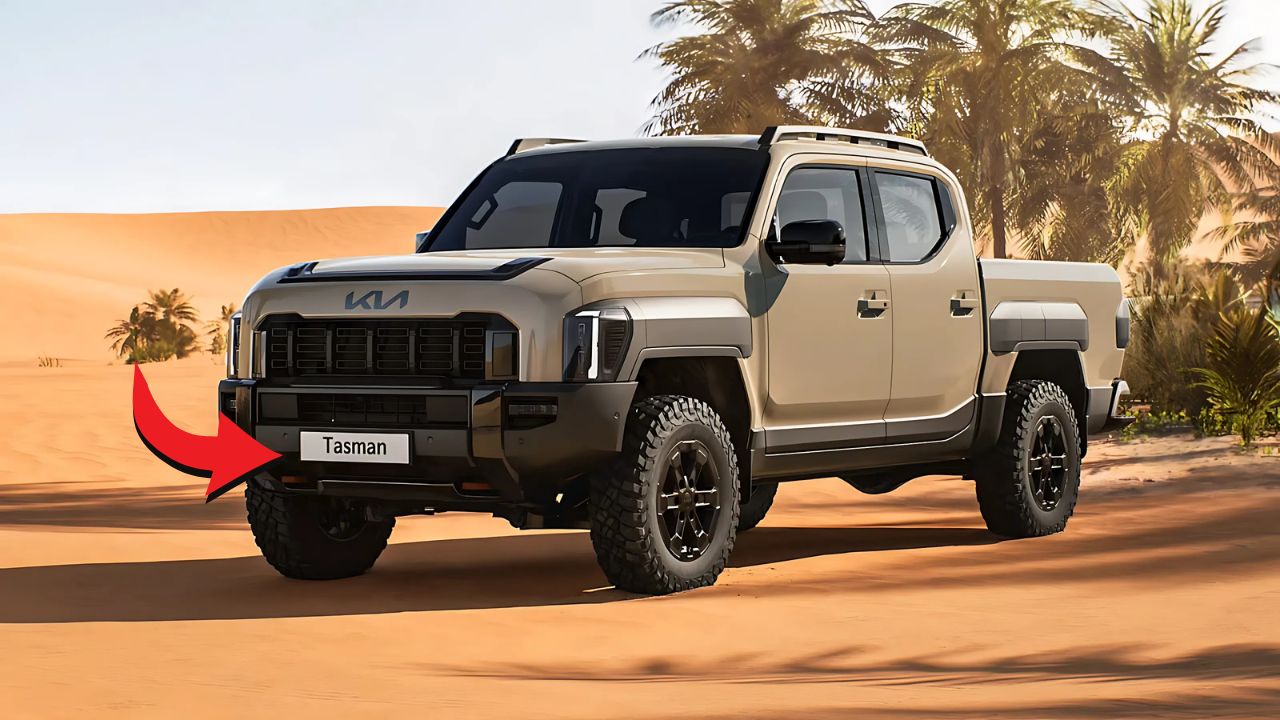The Australian automotive landscape has just witnessed a seismic shift. Kia’s first-ever pickup truck, the Tasman, has officially launched with order books now open across Australia. This marks a historic moment for the Korean automotive giant as it boldly enters the fiercely competitive ute segment.
Pre-orders are now open for the Kia Tasman in Australia, with both 4×2 and 4×4 variants available from $42,990 to $74,990 plus on-road costs. The timing couldn’t be more perfect, as Australian buyers have been seeking fresh alternatives to the established players.

Revolutionary Korean Design Meets Australian Toughness
Bold Aesthetic Departure
The Tasman represents something genuinely different in the pickup truck world. Kia deliberately ‘shunned the familiar form language that has dominated the pickup genre for decades’. Where competitors have played it safe with traditional American-inspired designs, Kia has taken a distinctly Korean approach.
The tiger-face grille has an interesting iteration that integrates a new pattern, while the headlamps have a vertical DRL. This creates an unmistakable presence on Australian roads. The boxy design language emphasizes functionality while maintaining Kia’s signature aesthetic elements.
Australian-Inspired Development
The vehicle is named after the Tasman Sea, located between Australia and New Zealand. This naming choice reflects the genuine commitment Kia has made to the Australian market. Kia Australia claimed a significant role in the development of the pickup truck and targeted around 10 percent of the pickup truck market share in the country.
The development process has been extensive and rigorous. The Tasman required four years of development and more than 18,000 quality tests. This thorough approach demonstrates Kia’s serious intentions in the Australian market.
Powerful 4×4 Diesel Performance
Heart of the Beast: 2.2L Turbo Diesel Engine
The powertrain specifications are impressive and competitive. At the heart of the Tasman is a 2.2L turbo diesel engine featuring 154kW of power and 440Nm of torque, paired with a smooth 8-speed automatic transmission. These figures position the Tasman squarely in competition with segment leaders.
Kia states that this configuration can accelerate from 0-100km/h in 10.4 seconds, with a top speed of 185km/h. While acceleration might not be the primary concern for ute buyers, these numbers demonstrate adequate performance for both work and recreational use.
Advanced 4×4 Capabilities
The four-wheel-drive system comes loaded with modern technology. Available Low Range gearing system & automatic rear electronic locking differential help navigate challenging terrain. These features ensure the Tasman can handle demanding Australian conditions.
Terrain mode optimises performance & safety across various conditions such as snow, mud, sand & rock. The X-Pro variant takes things further with enhanced off-road equipment and higher ground clearance.
Competitive Pricing Strategy
Aggressive Market Entry
Kia has positioned the Tasman competitively against established rivals. Pricing starts from $42,990 before on-road costs for the Tasman S 4×2, undercutting the most affordable Ford Ranger 4×2 dual-cab by $290. This aggressive pricing strategy demonstrates Kia’s determination to gain market share quickly.
The price progression across the range follows logical steps. Opting for the 4×4 adds $7000 to the purchase price ($49,990), while the SX steps up to $54,490 before on-roads, and the SX+ at $62,390 plus on-roads. The top-spec X-Pro commands a premium but delivers extensive equipment.
Value Proposition
Beyond competitive pricing, the Tasman offers substantial value through its equipment levels. The expansive 75cm combined integrated panoramic display with satellite navigation, DAB digital radio and wireless Android Auto & Apple Carplay compatibility provides helpful driving information. These features come standard across most variants.
Impressive Load and Towing Capabilities
Commercial Strength
The Tasman delivers serious commercial vehicle credentials. With over 1,000kg payload, the Tasman is a proper one-tonne ute. This capability ensures it meets the demands of Australian tradespeople and commercial users.
Fit an immense up to 1,173L (VDA) of cargo in the tub, including an Australian standard pallet. The load bed dimensions have been specifically designed to accommodate Australian requirements, showing Kia’s attention to local market needs.

Towing Excellence
The towing specifications are competitive with segment leaders. With a towing rating of 3,500kg & 350kg tow ball mass rating, the Tasman is up to the task. Whether hauling work trailers or recreational equipment, these figures provide confidence for demanding applications.
The integrated trailer brake control automatically applies the trailer brakes when you brake on the Tasman. This technology enhances safety and makes towing more manageable for less experienced drivers.
Interior Innovation and Comfort
Segment-Leading Space
Kia has prioritized passenger comfort in the Tasman’s design. Experience a ute where comfort is not an afterthought; with best-in-segment headroom, shoulder room & 2nd row legroom including rear seat slide & recline function – a segment first. These dimensions address common complaints about pickup truck rear-seat comfort.
The practical features extend beyond just space. Keep phones charged for both yourself and your passenger with built-in dual wireless chargers. Modern connectivity needs haven’t been overlooked in this working vehicle.
Versatile Interior Features
The centre console armrest also folds out to become a table to transform into a functional workspace. This innovative feature acknowledges that modern utes often serve as mobile offices for tradespeople and business users.
The rear seats fold up to reveal a generous best-in-class 45L of space under the seating. Storage solutions like this demonstrate thoughtful design for real-world usage scenarios.
Technology and Safety Focus
Advanced Safety Systems
Safety represents a key priority in the Tasman’s development. Kia says Australian fleet buyers told them a five-star ANCAP rating was a non-negotiable so Tasman has integrated passive and active safety systems such as a suite of airbags including a centre side airbag. This focus on safety reflects modern buyer expectations.
On board safety technology includes Kia’s effective blind spot view monitor, highway driving assist, blind spot collision avoidance assist, driver attention monitor, remote smart parking assist and rear cross traffic collision avoidance assist. These systems rival premium passenger cars in their sophistication.
Off-Road Technology
Ground View Monitor displays a virtual view of the terrain in front of the car, showing potential hazards & obstacles on the infotainment display. This technology helps drivers navigate challenging terrain with confidence, particularly useful for inexperienced off-road drivers.
Market Strategy and Launch Timeline
Phased Launch Approach
Kia has planned a strategic rollout for the Tasman in Australia. Dual Cab Pick-Up trims will arrive in Australia in July 2025, followed by Dual Cab Chassis models in August and Single Cab Chassis in late 2025. This phased approach allows Kia to manage demand and production effectively.
The timing positions the Tasman perfectly for the crucial end-of-financial-year sales period. Many Australian businesses make vehicle purchases before June 30, making the July launch strategically sound.
Sales Ambitions
Despite intense competition in the 4×4 ute segment, Kia is targeting 20,000 annual sales for the Tasman, representing around 10 per cent of total ute sales in Australia. These are ambitious but achievable targets given Kia’s growing reputation and the Tasman’s competitive positioning.
The broader context supports these aspirations. Pick-ups make up 18-20 per cent of monthly vehicle sales in Australia, making this segment crucial for any mainstream automotive brand’s success.
Challenging the Establishment
Taking on Ford and Toyota
The Tasman enters a market dominated by established players. Set to go head-to-head with the best-selling Ford Ranger and perennial favourite Toyota Hilux, the Kia Tasman fills a gaping hole in the Korean brand’s line-up in Australia. Breaking into this established market requires exceptional products and pricing.
However, Kia brings fresh perspective to a sometimes conservative segment. Roland Rivero, Kia Australia’s General Manager of Product Planning: “We set out as a brand to be different, to be distinctive in what is a fairly heritage type of conservative segment”.
Future Electrification Plans
Looking ahead, Kia has bigger plans for the Tasman platform. The first Kia ute will be available with a full range of body styles and drivelines, plus an all-electric version by 2026. This forward-thinking approach positions Kia ahead of many competitors in the electrification race.
Frequently Asked Questions
Q: When will the Kia Tasman be available in Australia?
A: The dual-cab pickup variants launch in July 2025, with chassis variants following in August and single-cab models in late 2025.
Q: How much does the Kia Tasman cost?
A: Pricing starts from $42,990 plus on-roads for the base 4×2 model, ranging up to $74,990 for the top-spec X-Pro variant.
Q: What engine powers the Australian Kia Tasman?
A: All Australian models feature a 2.2L turbo diesel engine producing 154kW power and 440Nm torque, paired with an 8-speed automatic transmission.
The Kia Tasman represents more than just another pickup truck entering the Australian market. It symbolizes a brand’s ambitious evolution and a genuine challenge to established players who may have become complacent. With competitive pricing, advanced technology, impressive capabilities, and distinctive design, the Tasman is positioned to capture significant market share.
Whether Kia can achieve its ambitious sales targets remains to be seen. However, the comprehensive approach to product development, pricing strategy, and market positioning suggests the Tasman has every chance of success. Australian buyers finally have a genuinely different option in the pickup truck segment, and that can only be good news for consumers seeking value, innovation, and capability in their next commercial vehicle purchase.

